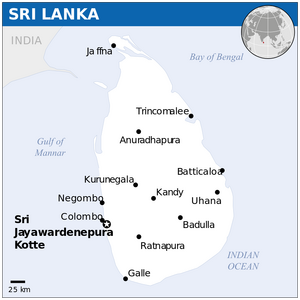Jambukola

Jambukola (जंबूकोल) or Dambakola Patuna (Sinhalese: දඹකොළ පටුන) is an ancient port to the north of Jaffna, in the Northern Province, Sri Lanka.[1] The ancient port of Jambukola is today identified as the tiny haven of Sambilthurai on the periphery of the village of Mathakal.
Variants
- Jambukola (जंबूकोल) (लंका) (AS, p.350)
- Jambukola (Mahavansa/Chapter 11, Ch.18, Ch.19, Ch.20)
- Sambalaturi संबलतुरि (लंका)= Jambukola (जंबुकोल) (AS,p.929)
History
After Mihindu Maha Thero brought Buddhism to Sri Lanka in 250 BC, his sister, Theri Sanghamitta arrived in Sri Lanka with a Sacred Bo Sapling one year later to this port. The temple Samudda-panasala (Jambukola Viharaya) was built commemorating the arrival of the Bo sapling by King Devanampiya Tissa (250-210 BC). Later, the same king planted one of the first eight shoots of the Sri Maha Bodhi, on the same place where he kept the original tree before bringing it to Anuradhapura.
King Vijayabahu I (1070–1110) has restored this site. The remains of the vihara, such as the Buddha footprint stone and vatadage seen up to recent times no longer exist there.
This port gradually faded in importance while port Mahathiththa/ Mahathota/ Mantota (now Mantai) located at the mouth of Malvatu oya developed as a key intersection of sea-routes and the Dambakola Patuna Viharaya was lost in time.
The Great Chronicle of Sri Lanka, the Mahavamsa and Samanthapaasasdika mention pilgrims coming from "Yonaka" country to Jambukola to worship the Jambukola Viharaya in the ancient times.
Present status
Unfortunately today there is nothing on the temple which shows any antiquity. Most of the structures in the temple including the stupa which has been completed in a record 65 days have been done by the Sri Lankan Navy. Even the current bo tree was planted in 1998 by the Navy.
In Mahavansha
Mahavansa/Chapter 11 mentions that Devanampiya Tissa, second son of Mutasiva, became king of Sri Lanka after his father's death. The king sent four persons appointed as his envoys: his nephew Maharittha, who was the chief of his ministers, then his chaplain, a minister and his treasurer, attended by a body of retainers, and he bade them take with them those priceless jewels. When they had embarked at Jambukola and in seven days had reached the haven in safety, and from thence in seven days more had come to Pataliputta, they gave those gifts into the hands of king Dhammasoka.....When the ministers had stayed five months, highly honoured they set forth with the envoys, on the first day of the bright half of the month Vesakha. Having embarked at Tamalitti and landed at Jambukola they sought out the king, when they arrived here on the twelfth day.
Mahavansa/Chapter 19 mentions that ....Ashoka's daughter Samghamitta brought the great Bodhi-tree to Jambukola with eleven bhikkhunis, and when he had caused those among whom Arittha was first to embark on that same ship, he fared forth from the city, and passing over the Vinjha-mountains the prince arrived, in just one week, at Tamalitti. ....Of the eight Bodhi-saplings one was planted at the landing place Jambukola.
जंबूकोल
विजयेन्द्र कुमार माथुर[2] ने लेख किया है ...जंबूकोल (AS, p.350) भारत के पड़ोसी देश श्रीलंका में स्थित गया है। इसका उल्लेख बौद्ध ग्रंथ महावंश 11, 23 में हुआ है। लंका नरेश देवानांप्रिय तिष्य ने भारत के सम्राट अशोक के पास अपने भागिनेय 'महारिष्ठ', 'पुरोहित', 'मंत्री' और 'गणक' इन चार जनों को दूत बनाकर बहुमूल्य रत्न, तीन जाति की मणियाँ, आठ जाति के मोती तथा अन्य वस्तुओं के साथ भेजा था। ये लोग जंबूकोल से नाव पर चड़कर सात दिन में ताम्रलिप्ति पहुँचे थे और वहाँ से एक सप्ताह में पाटलिपुत्र। जंबूकोल, लंका के उत्तरी समुद्र तट पर 'संबलतुरि' नामक बंदरगाह है। महावंश 19, 60 के अनुसार बोधिद्रुम की एक शाखा का अंकुर, जिसे अशोक की पुत्री संघमित्रा लंका ले गईं थी, जंबूकोल में आरोपित किया गया था।

